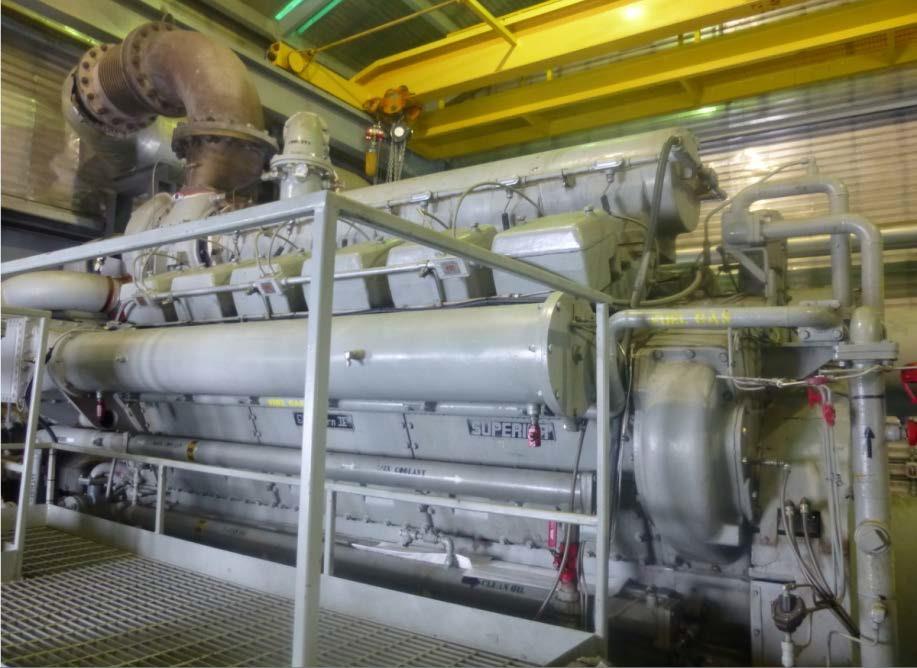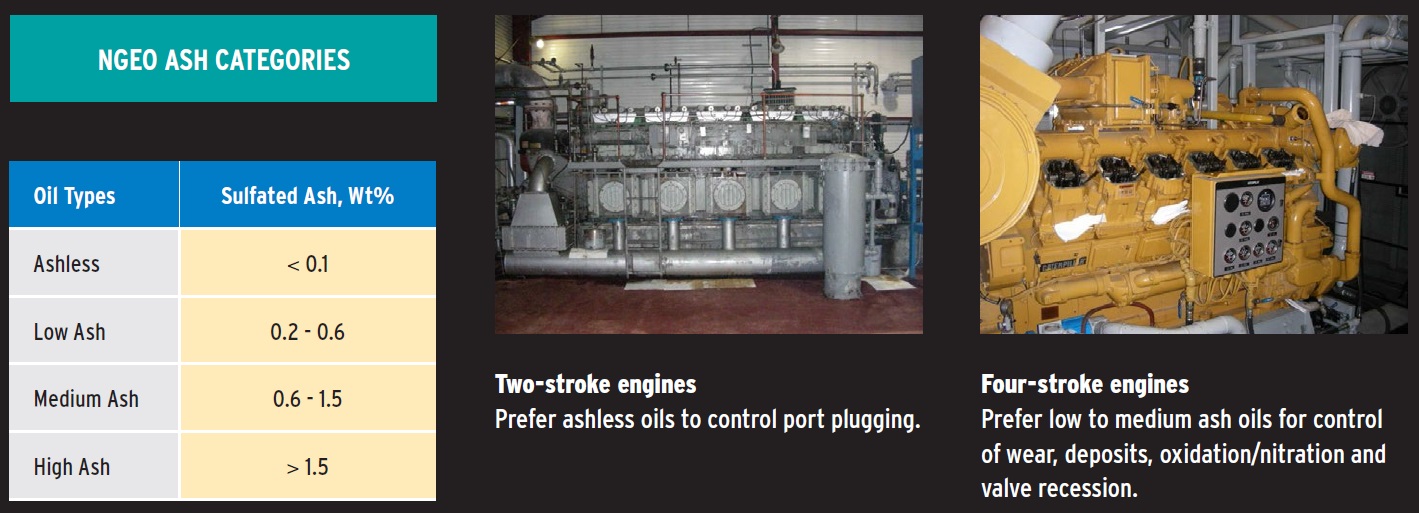Oils for natural gas engines
Stuart F. Brown, Contributing Editor | TLT Webinars January 2017
These engines have evolved over the years, and lubricant technology is keeping pace.

© Can Stock Photo / vikea
KEY CONCEPTS
•
Because natural gas burns hotter than diesel fuel or gasoline, the lubricating oil in these engines can operate under severe heat stress.
•
Natural gas is a ‘dry’ fuel that needs to be used with lubricating oil that produces ‘oil ash’ as a byproduct of combustion.
•
The classification system used for automobile oils doesn’t apply to natural gas-burning engines.
MEET THE PRESENTER
This article is based on a Webinar originally presented by STLE Education on Feb. 3, 2016. “Natural Gas Engine Oils” is available at
www.stle.org: $39 to STLE members, $59 for all others.
Kevin McDermott is a senior technical services advisor (TSA) for Petro-Canada Lubricants, Inc. He joined Petro-Canada in 1982 and has been a lubricants TSA since 2007. Prior to 2007 he worked in the maintenance of rotating equipment in the oil and gas industry for 25 years. McDermott also is an automotive and heavy-duty mechanic.
McDermott is a Certified Lubrication Specialist™. You can reach him at
kmcdermott@suncor.com.
 Kevin McDermott
Kevin McDermott
IN CIRCUMSTANCES WHERE NATURAL GAS IS AVAILABLE AS A FUEL FOR PISTON ENGINES, it can be burned under workloads ranging from very low to very high while engine rotational speed is often kept constant. Typical uses of such engines are in the oil and gas industry and in electric power generation where such tasks as compressing natural gas are common.
Because natural gas burns hotter than diesel fuel or gasoline, the lubricating oil in these engines can operate under conditions of severe heat stress when temperatures exceed 90 C, particularly in certain areas within the engine such as the cylinder walls, piston under-crowns and valve guides. This is a little too hot for an engine’s long-term health.
“In the lubes industry we have a rule of thumb, which says for every 10 degrees above 80 C, the oxidation rate doubles,” says Kevin McDermott, senior technical services advisor at Petro-Canada Lubricants, Inc. Oxidation, along with the related process of nitration, must be kept in check to assure that oil can fend off chemical degradation. McDermott presented his views at an STLE Education Webinar titled Natural Gas Engine Oils on Feb. 3, 2016 (
see box).
Compared to diesel fuel or gasoline, which are liquids, natural gas is a
dry fuel that needs to be used with lubricating oil that produces
oil ash as a byproduct of combustion. In the right concentration, ash will form a deposit on the seating surfaces of exhaust valves that are needed to prevent what’s known as valve recession. When the proper amount of ash is present—not too much and not too little—the faces of the exhaust valves and their hard metal seats located in the cylinder head are protected against the demon of recession. Too much ash, on the other hand, can permit excessive deposits to form and cause hot combustion gases to leak around the valve seats, burning them. Overly thick ash deposits also can behave as unwanted insulators that impede the natural flow of heat away from the valves. Bathed in a flow of fresh incoming fuel and air, intake valves run much cooler than exhaust valves and thus don’t need any ash to sustain their health (
see Figure 1).
 Figure 1. How much ash deposit is enough?
Figure 1. How much ash deposit is enough?
What lubrication oil formulation is the best one for a particular natural gas-fueled engine? It all depends.
Looking for an American Petroleum Institute service indicator label on an oil bottle won’t get you anywhere; the classification system used for automobile oils doesn’t apply to natural gas-burning engines. The user must proceed with lessons learned from field experience, along with specifications issued by engine manufacturers. Several engine OEMs list oils that are suitable for use in their equipment (
see Figure 2).
 Figure 2. Natural gas engine oil equipment.
Figure 2. Natural gas engine oil equipment.
Over the years natural gas engines have advanced immensely thanks to evolved mechanical designs and higher combustion temperatures that contribute to better fuel efficiency and power output for a given engine size. Along with these improvements, oils have been formulated with superior resistance to oxidation and nitration. Ash is derived from metallic elements in the additive package such as calcium, magnesium, zinc and phosphorous (
see Getting the Ash Content Right).
GETTING THE ASH CONTENT RIGHT
Factors affecting ash deposit accumulations
•
Engine make and model
•
Oil consumption rate
•
Engine load
•
Fuel gas composition
•
Engine setup
o
Air/fuel ratio
o
Exhaust gas temperature
o
Ignition timing
•
Foreign chemistry
o
Aftermarket additives
o
Coolant leaks
Oxidation occurs when oxygen is absorbed into the oil in an engine’s crankcase. Some of this oxygen comes from the small quantity contained in exhaust gases that sneak past the piston rings. More oxygen is pulled into the crankcase by the slightly negative pressure maintained in the engine’s interior. As the engine runs and time passes, acid forms in the oil, which then leads to the creation of sludge and varnish—which in turn trigger a viscosity increase—ultimately leading to corrosive wear and deposits in the piston ring area. There also are wear metals—specifically copper and iron—that end up in the oil where they catalyze oxidation reactions.
Two ratings that can always be found in the engine OEM’s specifications are viscosity grade and sulfated ash content, the most important variable of all. Finally, it’s essential to know that these processes can be accelerated by failing to change the oil according to schedule, which gives the chemical reactions too much time to do their work.
Nitration has very similar symptoms to oxidation, but it has a completely different cause. Instead of oxygen being absorbed, it’s the nitrogen dioxide (NOx) emissions from the combustion gases that are being absorbed. The same thing happens. We have oil acidity increasing and sludge, varnish, possibly along with viscosity increase. And we can start seeing corrosive wear.
Here are three little words of great importance to natural gas engine operators: oil level matters. When an engine has been overfilled with oil to the point where the spinning crankshaft is actually making contact with the surface of the oil in the sump, the resulting agitation and aeration cause excessive contact with the air, along with an increase in the rate of oxidation and nitration.
Natural gas engine oil is divided into four categories, with sulfated ash content (by weight) ranging from virtually none to a type called high ash, which contains 15 times the ash level found in so-called ashless oil (
see NGEO Ash Categories).

 You can reach free-lance writer Stuart F. Brown at www.stuartfbrown.com
You can reach free-lance writer Stuart F. Brown at www.stuartfbrown.com.